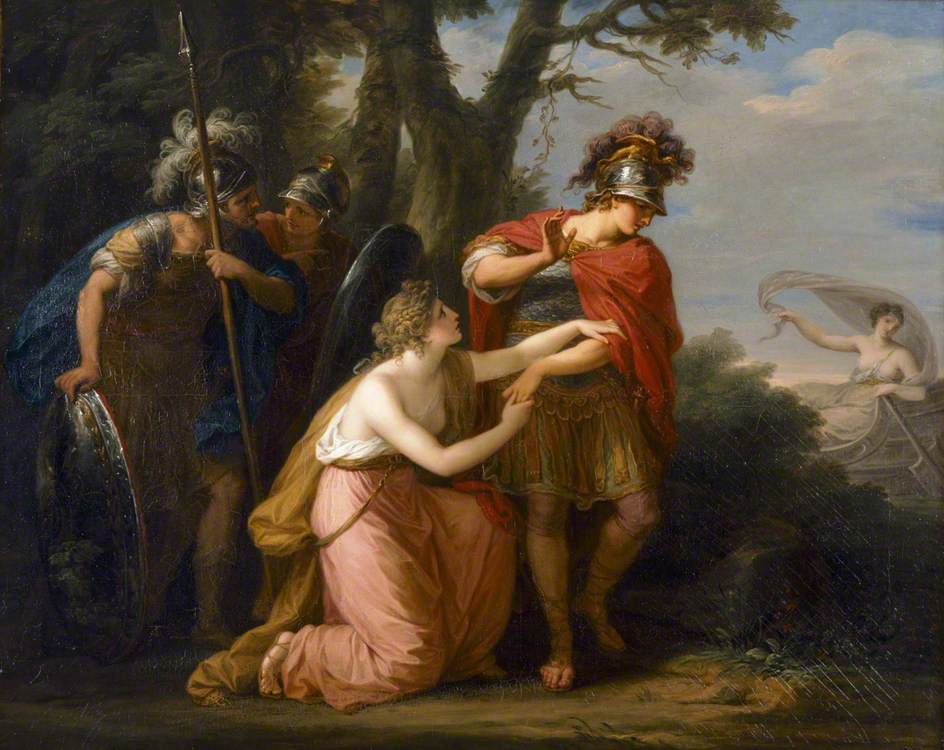Angelica Kauffman, Self Portrait at the Crossroads Between the Arts of Music and Painting, 1794, Nostell Priory
Angelica Kauffman has been badly served by both fate and the Royal Academy. In 2020, before COVID intervened, she was all set to have a landmark exhibition, a fitting tribute to the institution’s female founder-member (alongside Mary Moser). The planned show did go ahead in Dusseldorf, and featured around a hundred works under the title Angelica Kauffman: Artist, Influencer, Superwoman. Now, finally, four years later, the RA have gone with a truncated version - three rooms, thirty odd works. I've read plenty of reviews suggesting that this might be a blessing in disguise, that Kauffman could not have sustained a bigger exhibition. This seems a poor argument. The problem here isn't the art, it's the half-hearted way it's been presented. Where Dusseldorf trumpeted her contemporary superstar status and pan-European importance, the RA has been content to say 'Angelica Kauffman, woman artist', as if somehow that is the only reason to have the show. With little biography and less context, the exhibition asks a lot of its visitors, who are somehow expected to understand and appreciate paintings like Armida Begs Rinaldo in Vain Not to Leave Her.
I have also read a lot of reviewers bemoaning the fact that Kauffman is no Artemisia Gentileschi. True, but utterly irrelevant - pick two random male artists who lived more than a century apart and see how preposterous and pointless the comparison is. Kauffman was working within the eighteenth century European neoclassical tradition, her works channel the legacy of Poussin - often strikingly in her use of colour blocks - but also display elements of decorative softness such as you might see in French court painting. This is not a world of spurting blood and dramatic deaths: emotion is definitely here, but it is more subtle. This is art which was designed to speak to the mind as well as the gut. The subject material is drawn less from the Bible and more from mythology and literature: Armida and Rinaldo were the protagonists in an 1580 epic poem by Italian Renaissance poet Tasso, which tells how Rinaldo is deflected from his Christian duty as a crusading knight by a Saracen sorceress. Elsewhere in the exhibition we have Laurence Sterne and Euripides - these are not easily accessible narrative images for a twenty-first century audience.
Kauffman also needs to be understood in a European context, and this exhibition has a decidedly parochial feel. Perhaps inevitably, given that it is produced by the RA, there is an emphasis on Kauffman's relationship with the institution and its founder, Joshua Reynolds. We have the much quoted Zoffany in which male founders of the Academy gather around a life model, with Kauffman and Moser relegated to portraits on the wall. More interesting is the strikingly forceful letter in which Kauffman stood up to Nathaniel Hone's insulting parody of her. This alone gives a sense of the strength of character which was probably necessary to succeed as a woman in a masculine dominated art world. But there were other strong women: Richard Samuel's 1779 Portraits in the Characters of Muses at the Temple of Apollo, shows Kauffman amongst her female peers. What we don't have is a sense of the depth and range of her influence, seen as far afield as Russian court portraiture, and sustained by the vast market in prints of her works. In comparison, artists like Reynolds and Gainsborough were provincial nobodies.
Angelica Kauffman, Armida Begs Rinaldo in Vain Not to Leave Her, 1776, Kenwood House
In the end, however, an exhibition hangs or falls by what is on the display. Kauffman's self-representations have too much of an agenda to be insightful, although it is impossible not to be awed by the ambition and sheer chutzpah of Self Portrait at the Crossroads Between the Arts of Music and Painting. Paradoxically she seems less at ease in portraying of women, almost as if the knowledge that presentation was everything gets in the way: her generic muses for the RA ceiling decorations are more believable, rounded characters than some of her portraits. Although it was much less common for female artists to paint men, it is these works which show her portraitist's skill. You can see in the informal warmth of her portrait of Reynolds how the scandalmongers might have found their material. And I would love to put her view of David Garrick alongside Gainsborough's: there is an unfussy honesty about Kauffman's interpretation of a man famous for his ability to act.
Much of her mythological works have a frieze-like staginess, deliberately easy-to-read gestures and cursory backgrounds. It is the style of the period. What Kauffman does differently is put both her female characters and the emotional world they represent, centre-stage. But what catches your eye are the, dare I say, feminine details. Garlands are exquisitely painted, precise patterning, hair decorations, fabrics are all picked out, considered. This is not to belittle her, or create a 'feminine aesthetic' in her work, but it does give her neoclassicism a uniqueness. It works alongside her tendency to soften male figures - not so much a feminising as an emotionalising - which can be linked to eighteenth-century ideas of sentiment. Kauffman was a canny operator: determined to conquer the 'masculine' territory of history painting, she cultivated a Poussin-esque style, yet softened it into her own, distinctive version which points the way forward to more Romantic treatments. To really appreciate this, however, you need some comparative examples, some context. A cleverer curation might have been able to point these up and suggest why 'artist, influencer, superwoman' may not be that much of an exaggeration.
_-_Self_Portrait_of_the_Artist_Hesitating_between_the_Arts_of_Music_and_Painting_-_960079_-_National_Trust.jpg/800px-Angelica_Kauffmann_(1741-1807)_-_Self_Portrait_of_the_Artist_Hesitating_between_the_Arts_of_Music_and_Painting_-_960079_-_National_Trust.jpg)



No comments:
Post a Comment